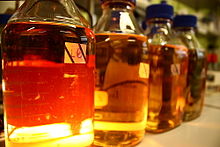How To Make Lb Broth

LB medium bottle and LB agar plate

Lysogeny broth (LB) is a nutritionally rich medium primarily used for the growth of leaner. Its creator, Giuseppe Bertani, intended LB to stand for lysogeny broth,[1] simply LB has also come to colloquially mean Luria broth, Lennox broth, life goop or Luria–Bertani medium. The formula of the LB medium was published in 1951 in the first paper of Bertani on lysogeny. In this article he described the modified single-burst experiment and the isolation of the phages P1, P2, and P3. He had developed the LB medium to optimize Shigella growth and plaque formation.[1] [ii]
LB media formulations take been an industry standard for the cultivation of Escherichia coli as far back equally the 1950s.[iii] [4] [5] [half dozen] [7] These media have been widely used in molecular microbiology applications for the training of plasmid Dna and recombinant proteins. It continues to be one of the well-nigh common media used for maintaining and cultivating laboratory recombinant strains of Escherichia coli.[viii] For physiological studies however, the use of LB medium is to be discouraged.[9]
There are several common formulations of LB. Although they are unlike, they by and large share a somewhat similar composition of ingredients used to promote growth, including the post-obit:
- Peptides and casein peptones
- Vitamins (including B vitamins)
- Trace elements (e.g. nitrogen, sulfur, magnesium)
- Minerals
Sodium ions for transport and osmotic remainder are provided by sodium chloride. Tryptone is used to provide essential amino acids such as peptides and peptones to the growing bacteria, while the yeast extract is used to provide a plethora of organic compounds helpful for bacterial growth. These compounds include vitamins and certain trace elements.
In his original 1951 paper, Bertani used 10 grams of NaCl and ane gram of glucose per one 50 of solution; Luria in his "L broth" of 1957 copied Bertani's original recipe exactly.[6] Recipes published subsequently have typically left out the glucose.
Formulae [edit]
The formulations generally differ in the corporeality of sodium chloride, thus providing selection of the appropriate osmotic conditions for the particular bacterial strain and desired culture weather. The low salt formulations, Lennox and Luria, are ideal for cultures requiring table salt-sensitive antibiotics.
- LB-Miller (10 g/Fifty NaCl)
- LB-Lennox (5 g/L NaCl)
- LB-Luria (0.5 yard/L NaCl)
Preparation [edit]

The following is a common method for the preparation of 1 litre of LB:
- Measure out the following:
- 10 g tryptone
- 5 thousand yeast extract
- 10 or 5 or 0.5 g NaCl every bit required (see Formulae to a higher place; some leaner are sensitive to NaCl)
- Suspend the solids in ~800 ml of distilled or deionized water.
- Add further distilled h2o or deionized water, in a measuring cylinder to ensure accuracy, to brand a total of i liter.
- Autoclave at 121 °C for twenty mins.
- After cooling, swirl the flask to ensure mixing, and the LB is gear up for use.
Adjusting the pH [edit]
Prior to autoclaving, some labs adjust the pH of LB to 7.5 or 8 with sodium hydroxide. However, sodium hydroxide does non provide any buffering chapters to the media, and this results in rapid changes to the pH during bacteria cultivation. To become around this some labs prefer to adjust the pH with v-ten mmol/50 TRIS buffer, diluted from 1 mol/L TRIS stock at the desired pH. However, information technology is not absolutely necessary to conform the pH for most situations. Some labs suit the pH to 7.0 merely every bit a precaution.
Since the buffering with TRIS will likewise be largely ineffective in the face of substantial bacterial growth, adjusting the pH of LB in this particular manner is usually unnecessary. As such, use of TRIS in some broth recipes (especially when the culture will be stored at room temperature atmospheric condition for extended periods of time) may exist considered a superstitious procedure without much scientific merit.
Encounter also [edit]
- Agar plate
- Salvador Luria
- SOC medium—another widely used medium for culture of Escherichia coli in molecular biology work
References [edit]
- ^ a b Bertani, G. (2004). "Lysogeny at mid-twentieth century: P1, P2, and other experimental systems". Journal of Bacteriology. 186 (3): 595–600. doi:x.1128/JB.186.3.595-600.2004. PMC321500. PMID 14729683.
- ^ Bertani, Thou (1951). "Studies on lysogenesis. I. The fashion of phage liberation past lysogenic Escherichia coli". J. Bacteriol. 62 (3): 293–300. doi:x.1128/jb.62.3.293-300.1951. PMC386127. PMID 14888646.
- ^ Miller, J. H. (1972). Experiments in molecular genetics. Cold Spring Harbor Laboratory, Common cold Bound Harbor, New York.
- ^ Luria, S. E.; Adams, J. N.; Ting, R. C. (1960). "Transduction of lactose-utilizing ability amidst strain of Eastward. coli and S. dysenteriae and the properties of the transducing phage particles". Virology. 12 (3): 348–390. doi:10.1016/0042-6822(60)90161-six. PMID 13764402.
- ^ Lennox, Eastward. South. (1955). "Transduction of linked genetic characters of the host by bacteriophage P1". Virology. 1 (2): 190–206. doi:10.1016/0042-6822(55)90016-7. PMID 13267987.
- ^ a b Luria, S. Eastward.; Burrous, J. W. (1957). "Hybridization between Escherichia coli and Shigella". J. Bacteriol. 74 (4): 461–476. doi:ten.1128/jb.74.4.461-476.1957. PMC289941. PMID 13475269.
- ^ Anderson, E. H. (1946). "Growth requirement of virus-resistant mutants of Escherichia coli strain B". Proc. Natl. Acad. Sci. USA. 32 (v): 120–128. doi:10.1073/pnas.32.v.120. PMC1078898. PMID 16588724.
- ^ Sambrook, J., E. F. Fritsch, and T. Maniatis. (1989). Molecular cloning: a laboratory manual, second edition. Cold Bound Harbor Laboratory, Cold Spring Harbor, New York.
- ^ Nikaido, H. (2009). The Limitations of LB Medium. Small things considered - The Microbe Blog. ASM. http://schaechter.asmblog.org/schaechter/2009/eleven/the-limitations-of-lb-medium.html
Source: https://en.wikipedia.org/wiki/Lysogeny_broth
Posted by: mosbyquet1991.blogspot.com


0 Response to "How To Make Lb Broth"
Post a Comment